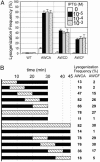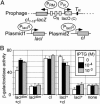Role of the lytic repressor in prophage induction of phage lambda as analyzed by a module-replacement approach
- PMID: 16537413
- PMCID: PMC1450210
- DOI: 10.1073/pnas.0511117103
Role of the lytic repressor in prophage induction of phage lambda as analyzed by a module-replacement approach
Abstract
Using a module exchange approach, we have tested a long-standing model for the role of Cro repressor in lambda prophage induction. This epigenetic switch from lysogeny to the lytic state occurs on activation of the host SOS system, which leads to specific cleavage of CI repressor. It has been proposed that Cro repressor, which operates during lytic growth and which we shall term the lytic repressor, is crucial to prophage induction. In this view, Cro binds to the O(R)3 operator, thereby repressing the cI gene and making the switch irreversible. Here we tested this model by replacing lambda Cro with a dimeric form of Lac repressor and adding several lac operators. This approach allowed us to regulate the function of the lytic repressor at will and to prevent it from repressing cI, because lac repressor could not repress P(RM) in our constructs. Repression of cI by the lytic repressor was not required for prophage induction to occur. However, our evidence suggests that this binding can make induction more efficient, particularly at intermediate levels of DNA damage that otherwise cause induction of only a fraction of the population. These results indicate that this strategy of module exchange will have broad applications for analysis of gene regulatory circuits.
Conflict of interest statement
Conflict of interest statement: No conflicts declared.
Figures




References
-
- Herskowitz I., Hagen D. Annu. Rev. Genet. 1980;14:399–445. - PubMed
-
- Ptashne M. A Genetic Switch: Phage Lambda Revisited. Woodbury, NY: Cold Spring Harbor Lab. Press; 2004.
-
- Kourilsky P. Mol. Gen. Genet. 1973;122:183–195. - PubMed
-
- Roberts J. W., Devoret R. In: Lambda II. Hendrix R. W., Roberts J. W., Stahl F. W., Weisberg R. A., editors. Woodbury, NY: Cold Spring Harbor Lab. Press; 1983. pp. 123–144.
Publication types
MeSH terms
Substances
Grants and funding
LinkOut - more resources
Full Text Sources

